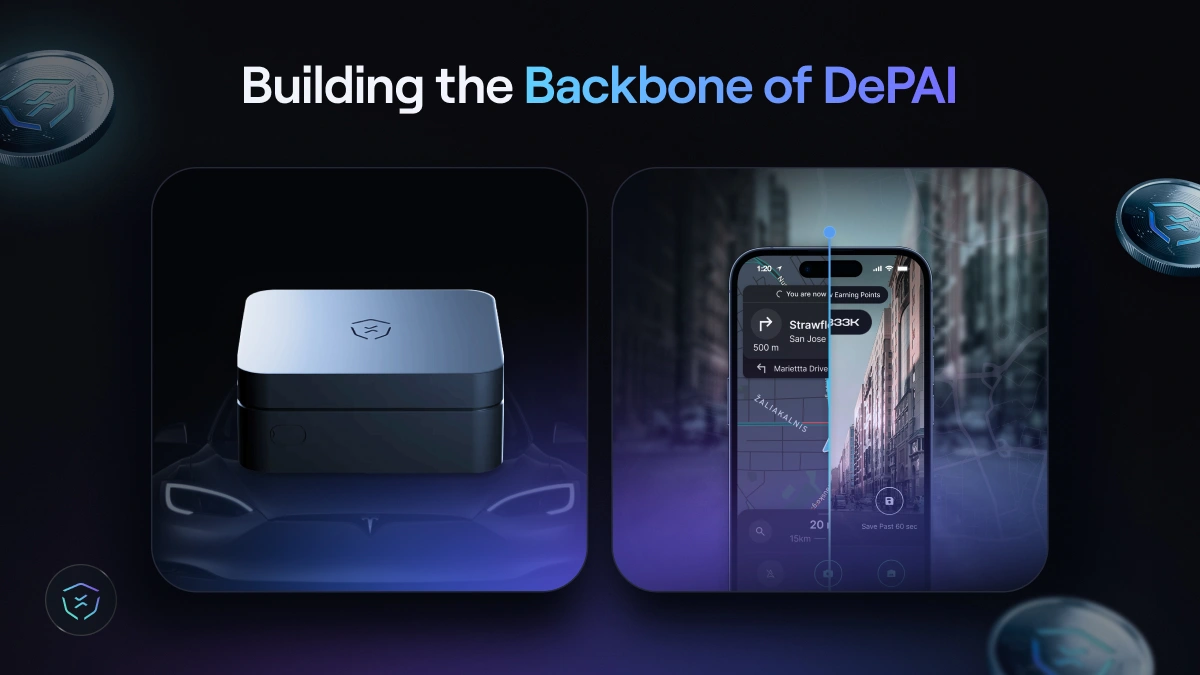
.webp)
The fusion of Decentralized Physical Infrastructure Networks (DePIN) and Artificial Intelligence (AI) is opening new frontiers in automation, robotics, and real-world data processing. This emerging field, known as Decentralized Physical Artificial Intelligence (DePAI), shifts AI away from centralized data silos and into decentralized networks where real-world users contribute to machine learning, decision-making, and optimization processes.
By leveraging DePIN and blockchain incentives, DePAI enables a more autonomous, transparent, and efficient framework for AI-powered physical systems. This shift is already transforming industries such as mobility, logistics, urban planning, and robotics, where access to real-world, continuously updated data is critical.
DePIN provides the foundation for the real-world data streams necessary for decentralized AI training and deployment. Unlike traditional AI models that depend on controlled datasets, DePAI harnesses crowdsourced, real-world contributions to improve AI adaptability.
For instance, Smartphone DePIN has revolutionized data collection through applications like Drive&, which turns everyday commuting into a decentralized mapping tool. With over 235,000+ active users, Drive& has mapped over 146 million kilometers, providing real-time traffic and infrastructure insights. This continuously evolving dataset enhances AI-driven navigation, urban planning, and mobility solutions. NATIX coverage map visualization of collected metadata is astonishing as it demonstrates previously unimaginable scale and timeframe for worldwide data collection and processing.
By eliminating centralized control, DePIN ensures that AI models remain diverse, contextually relevant, and continuously updated. Moreover, the integration of blockchain incentives ensures that contributors are fairly rewarded, fostering long-term engagement and ecosystem sustainability.

For DePAI to function efficiently, it requires a robust incentive system that encourages users to contribute real-world data. This is where DePIN Crypto plays a pivotal role.
Through tokenized rewards, DePIN Crypto compensates contributors for sharing data from mobile devices, autonomous vehicles, and IoT sensors. It also facilitates governance, allowing participants to influence ecosystem developments.
A leading example of this model is $NATIX, the native cryptocurrency of NATIX Network. Through blockchain-based rewards, staking opportunities, and deflationary mechanisms, $NATIX ensures a sustainable, long-term economic structure for decentralized AI networks.
Periodic token burns and buybacks further enhance the ecosystem’s token economy by reducing supply and stabilizing value, creating a self-sustaining economy that benefits both contributors and long-term token holders. $190M+ $NATIX have already been burned via this mechanism, further aiding the deflationary token economy.
As the automotive industry advances toward full autonomy, Tesla DePIN is emerging as a key enabler of AI-driven transportation. By integrating decentralized networks with autonomous vehicle technologies, DePAI crowdsources data to improve the efficiency, safety, and scalability of AI-powered mobility systems.
The NATIX VX360 device exemplifies this approach by seamlessly integrating into Tesla vehicles. VX360 allows owners to store up to 256 GB of vehicle camera footage while contributing dynamic geospatial data to decentralized networks.
By leveraging blockchain-based incentives, VX360 users are rewarded for enhancing AI-driven mapping and navigation. This data is crucial for scenario generation, real-time hazard detection, and optimizing self-driving algorithms—allowing autonomous vehicles to adapt to a variety of real-world conditions. This intelligence also lays the ground for AI-powered Visual Positioning System (VPS) technologies, which are used to reconstruct a 3D replica of our world for Physical AI to understand and interact with the environment more intelligently than ever before.
Through Tesla DePIN, decentralized AI-powered mobility solutions can evolve beyond proprietary data silos, creating a more collaborative and adaptive infrastructure for self-driving technologies.

While AI and machine learning drive DePAI’s innovation, the success of these systems depends on DePIN’s infrastructure. DePIN provides the necessary physical and digital framework to ensure continuous, real-time data collection from diverse environments.
Unlike traditional AI models that rely on pre-collected, often outdated datasets, DePIN enables ongoing, self-improving AI systems. With millions of decentralized contributors, AI applications gain access to real-time, high-quality insights that enhance adaptability and scalability.
One of the most critical applications of DePIN-powered AI is in autonomous robotics and self-driving technologies. Training AI for real-world navigation requires billions of miles of driving data, yet centralized training models fail to capture the full spectrum of real-world driving conditions. By utilizing decentralized networks, DePIN ensures continuous updates and adaptability, making AI-powered mobility safer and more reliable.
The integration of blockchain technology in DePIN introduces transparency, security, and reward-based incentives. Data contributors, whether through VX360, Drive& App, or other DePIN-powered platforms, receive fair compensation while maintaining data privacy and control.
By combining DePIN and DePAI, the NATIX ecosystem is bridging the gap between AI, blockchain, and real-world applications. This collaborative model is paving the way for a decentralized, AI-powered infrastructure, where data is shared, validated, and utilized securely.
Although DePAI has gained traction in mobility and navigation, its applications extend far beyond transportation. Future implementations could include:
By democratizing access to real-world data, DePAI expands AI applications into fields previously dominated by centralized players.

As a pioneering force in the DePIN and AI sectors, NATIX Network is laying the groundwork for a more decentralized, intelligent infrastructure. Through platforms like VX360, the Drive& App, and the $NATIX token, NATIX is pioneering a new approach to AI-powered decentralized infrastructure.
By enabling AI developers, researchers, and businesses to access high-quality, real-world datasets, NATIX is reshaping how AI models are trained and optimized. This user-driven, decentralized approach makes DePAI faster, more accessible, fair, and scalable than traditional AI models.
The rise of DePAI marks a turning point in artificial intelligence, shifting control from corporate entities to decentralized networks. By combining DePIN with blockchain incentives, NATIX Network and similar projects are proving that AI-driven, decentralized collaboration is not just a concept—it is already a reality.
As adoption accelerates, DePAI has the potential to revolutionize AI applications—ensuring that AI benefits a global community rather than a select few corporations.
With DePIN, DePAI, and blockchain-based incentives working together, the future of AI is becoming decentralized, intelligent, and unstoppable—shaped by those who contribute to it, rather than those who control it.